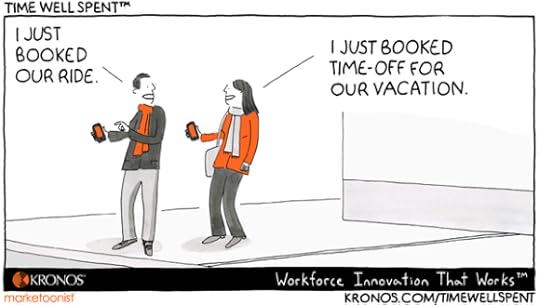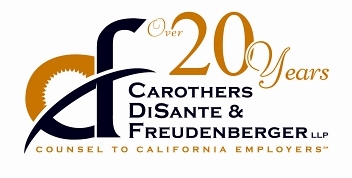Sharlyn J. Lauby's Blog, page 124
January 23, 2018
What Employers Should Do When an Employee Resigns – Ask #HR Bartender
A couple months ago, I wrote an article about how to properly resign from your job. Shortly after, I received a note from an employer about a challenge they’re facing, and it reminded me that organizations need to know what to do when an employee resigns too. Here’s the reader note:
As an employer, I had an employee who was working on an important project that didn’t even resign, they just left and never responded.
Three weeks later, my current team planned a get-together where this employee was invited. After dinner, they came back to the office to chat and hangout. I happened to stop by the office and saw them sitting there. I didn’t speak to the employee.
Afterward, I asked my team not to socialize with former employees. I realized after I said it that it wasn’t the right thing to do. What should I have had done in such a case?
Now, I must admit, the reader’s note is pretty specific and I’m not sure every company will face the same type of situation. But there are a few things that organizations need to keep in mind when an employee resigns.
Have a policy about guests visiting the office. This is just a good policy to have in general. Offices are work environments. Companies might want to have guidelines about employees “hanging out” when they’re off duty. And they might want to have a policy about guests visiting the workplace. That includes family, friends, and former employees.
Follow-up with employees who do a “no call, no show”. It’s possible that an employee who doesn’t call or show up for work is in fact tendering their resignation. It’s also possible that the employee has been in an accident or had a family emergency. So, companies should try to contact employees who do not show up for their scheduled shift.
Don’t make current employees choose sides. Whether an employee resigns voluntarily or involuntarily, they still have friends inside the company. Don’t make employees choose between their former co-worker and the company. Treat employees as adults and hold them accountable for conducting themselves in a professional manner.
Wish the employee well. Regardless of the circumstances of the employee’s departure, always wish the employee well. Even if they were the worst employee you’ve ever hired, let them leave with as much dignity and respect as possible. I’ve run into employees in the grocery store that I fired months earlier and they stopped to say “hello”.
Discuss goals for the notice period. If an employee resigns and is providing a two-week notice, find time to talk about current projects. Figure out what can be accomplished before the employee leaves. Talk about having debriefs so the exiting employee can transition work tasks smoothly before they leave.
Explain offboarding. Employees do not know what happens when they tender their resignation. They just know that they’re leaving. So, they will have questions about their vacation balance, health insurance, 401(k), etc. Make sure that employees know the company will answer their questions.
Schedule an exit interview. Often, exit interviews are conducted by HR or an external third-party. Sometimes they happen during an employee’s notice period or they happen a couple of weeks after an employee leaves. However your organization conducts exit interviews, let the employee know. And encourage them to give honest feedback.
Talk with HR and department managers about workload. Chances are the company is going to be a few days weeks months without a replacement hire. That means the company needs to figure out how the work is going to get done. Organizations can pay employees overtime, hire a freelancer, or look at other options.
Don’t hesitate to call your employment attorney. At any point in this process, companies should call their legal counsel if something doesn’t feel right or they have questions. That’s why HR pros develop a relationship with an attorney. Instead of taking action and regretting it, spend an hour and talk it out.
The way an employee resigns says a lot about them. The same holds true for the company and how they handle exiting employees. Both the employee and the organization have obligations when its time to part ways. If you like this list, feel free to bookmark it for future reference and share it with your managers, so they handle employee resignations properly. The job market is way too challenging right now not to have a strong offboarding program.
Images captured by Sharlyn Lauby
The post What Employers Should Do When an Employee Resigns – Ask #HR Bartender appeared first on hr bartender.






January 21, 2018
6 Recruiting Activities That Will Help Companies Hire Top Talent
According to the December 2017 jobs report, U.S. unemployment is at 4.1 percent, a 17-year low. Obviously, this is good news. We want everyone who wants a job to have a job. However, it’s also a challenge. Really low unemployment means that recruiting is tougher. A lot tougher! It can take much longer to find qualified candidates and fill open positions.
There’s lots of talk about recruiters needing to get creative when it comes to developing staffing strategies and sourcing talent. And I totally agree. Organizations have to be willing to try new things, monitor candidate flow, and measure results.
But equally important is getting the foundation right. Here are some of the most popular recruiting posts on HR Bartender. I think they represent key activities that recruiting teams need to have in order to find the best talent.
The 10 Skills Every Recruiter Should Have
Every recruiter needs to perform at a high level. Having the right skills is important. Use this list to help develop effective skills in every recruiter.
10 Strategies for Recruiting in a Highly Competitive Job Market
Recruiting can be a challenge during normal times. To recruit in a highly competitive job market, consider using some of these proven strategies.
The Difference Between Applicants and Candidates
Job candidates differ from applicants. It seems like a simple concept, but it’s an important one. It drives decisions about the candidate experience and the level of service they receive.
The Real Reason for Job Titles
Job titles have evolved over the years. But, they serve a real business purpose. And employees should want their job title to align with job responsibilities.
How to Find Bottlenecks in Your Talent Acquisition Process
When your recruiting process isn’t working well, everyone blames HR. You can find talent acquisition bottlenecks to keep your pipeline flowing.
Pre-Employment Tests Can Help HR Hire Faster (and Better)
Hiring the right candidate has never been more important. Pre-employment tests can help HR hire faster and better. But, you have to find the right tests.
In 2018, there’s no doubt that organizations will need to make investments into their talent acquisition strategy and processes. It’s the way they will stand out from their competitive set. Developing recruiters, understanding trends, problem-solving, and using the right tools will help organizations find, select, and hire the best talent.
P.S. I’m delighted to share with you that I’m facilitating a Society for Human Resource Management (SHRM) virtual seminar on “Talent Acquisition: Creating Your Organization’s Strategy”. This program takes us through the entire talent acquisition process from employment branding to sourcing to selection and finally onboarding. Registration details can be found on the SHRM website. Hope you can join us!
The post 6 Recruiting Activities That Will Help Companies Hire Top Talent appeared first on hr bartender.






January 19, 2018
Bookmark This! 10 Articles that Managers Need to Read
Not that we all aren’t busy, but managers are very busy people. We ask them hire, coach, discipline, and train employees. We ask them to do the work of managing, organizing, and directing the work. We expect managers to do all of this while demonstrating work-life balance and setting a good example for others.
Let’s face it…it’s a very tall order.
So, sometimes we’re not met with enthusiasm when we ask a manager to take it upon themselves to read blogs and books as a form of professional development. But one thing that we could do, is give a manager some guidance about what we do want them to read. For example, here’s a list of the ten most popular posts on HR Bartender related to management development. No single article would take more than ten minutes to read.
The 10 Basic Skills that Every Manager Should Have
There are skills that every employee should have. Managers need those too, plus a few others. These are the 10 basic skills every manager needs to have.
10 Tips for First-Time Supervisors
Many first-time supervisors struggle at first. And it’s understandable. Here are 10 tips for first-time supervisors that will help make you successful.
7 Things New Managers Should Do in the First 6 Months
New managers are often placed in their roles without much – if any – onboarding. Now what? Here are 7 things new managers should do in the first 6 months.
10 Recruiting Tips for First Time Managers
Knowing how to recruit top talent is important. And every new manager need strong recruiting skills. Here are 10 recruiting tips for first time managers.
10 Performance Management Tips for the First Time Supervisor
The first-time supervisor can dread their first performance management task. Here are 10 performance management tips for a first-time supervisor.
10 Activities that Encourage Employees to Take the Lead in Their Development
Managers and employees need to work together to encourage career development. Here are 10 things companies can do for managers and employee development.
HOW TO: Have a Performance Conversation with An Employee
When you need to have a performance conversation with an employee – you need to be prepared. Follow this outline for effective performance meetings.
Overcoming 5 Common Performance Appraisal Biases
Many different kinds of performance appraisal biases can show up during the process. These are five common ones every manager should overcome.
The 10 Habits Great Managers Use to Engage Employees
Managers have a tough job. Great managers use these 10 habits to include every employee in the business. That builds employee engagement.
6 Qualities in a Leadership Role Model
Whether it’s Steve Jobs or Robert Greenleaf, leadership role models have qualities we admire and want to possess. Here are 6 qualities that are frequently found in a leadership role model.
I hope you’ll consider bookmarking this list and sharing it with managers. They can afford ten minutes a day to read one article. If they’re not already doing it, maybe it will spark them to create a RSS, subscribe to some blogs, and read a few books during 2018.
Reading can be a great form of professional development. And a cost effective one as well. It takes getting people excited about learning in this format. Start with short articles then gradually move up to longer reads. It’s the smart thing to do.
Image captured by Sharlyn Lauby at the Wynwood Walls in Miami, FL
The post Bookmark This! 10 Articles that Managers Need to Read appeared first on hr bartender.






January 18, 2018
Embrace Back of the Room Learning
I have a confession to make. I’m a back of the room learner.
When I attend conferences, workshops, seminars, or training sessions, I like to sit in the back of the room. And I must admit, it’s a bit unnerving when I get called out by someone for sitting in the back of the room. I’ve been quiet on this topic for quite some time, but decided to share my thoughts.
It’s time for presenters, speakers, and trainers to stop calling out people who sit in the back of the room. There are a couple of reasons that people do it.
They’re trying to be considerate. An attendee knows that their boss or a caregiver or their kids are going to call so they sit in the back of the room so they can quickly and quietly excuse themselves when the call arrives.
They’re trying to help market the speaker. A participant wants to live blog or Tweet during the session so they don’t want others to be subjected to hearing them type.
But the last one, and IMHO the most important one, is that the participant is comfortable in the back of the room. And when they’re comfortable, they learn best. This makes the experience learner-centric (versus speaker-centric).
Now, I will fully admit that there are moments when participants need to realize that back of the room doesn’t mean anti-social. This is especially true during training, when there are activities and discussion. During a presentation, where the majority of the content is being delivered via lecture, where a person sits should be immaterial.
If the problem is that a presenter is in a large room and everyone is sitting in the back, that’s not the participant’s problem. Frankly, that’s the meeting planner’s issue. And, cajoling all of the participants isn’t the solution.
The reason I’m bringing this up is because people have lots of options when it comes to their learning and professional development. And professional development is expensive. Individuals want a valuable experience, which includes being comfortable. I’m not talking about comfortable just in the context of stretching the mind or learning something new. I’m talking about comfortable in terms of ease and relaxation.
In fact, it could be said that one of the best ways for individuals to embrace learning “uncomfortable” topics is from a place of comfort. Just something to think about as we approach spring conference season. Let people sit where they want. Hold them accountable for the content. (Thanks for letting me rant about it.)
Image of Sharlyn Lauby captured from the back of the room during the HR Florida Annual Conference.
The post Embrace Back of the Room Learning appeared first on hr bartender.






January 16, 2018
Organizations Need to Address the Core Issues with Performance Reviews
There continues to be discussion about “ditching” or “killing” the traditional annual performance review. I get it. The business world has changed and older processes, like the annual performance review, need to change along with it.
But I think we need to be careful that we don’t sell the notion of dropping the annual performance review as some sort of silver bullet that will cure all of the organization’s performance issues. The performance review is only one piece of the overall performance management process. Like any process, removing or reducing one piece of it, puts extra emphasis on the remaining components of the process.
So, organizations thinking about eliminating the annual performance review have to look at their performance management philosophies to ensure they’re not simply removing a symptom – instead of addressing the cause.
During last year’s WorkHuman Conference, pioneered by Globoforce, I heard several speakers talk about the annual performance review. Here are three takeaways that I believe we need to keep top of mind:
Companies don’t do performance reviews to inflict punishments. I’m confident that the performance review wasn’t started in a conference room somewhere under the guise of “We need to implement a process that managers will loathe and employees have no confidence in.” Performance reviews serve several organizational purposes including providing feedback, assisting with selection in promotions and transfers, and compensation. The performance review is only a form of punishment if the company lets it become that. Organizations looking to bring performance reviews into the 21st Century will have to deal with public opinion.
Performance reviews have a competition component to them. Let’s face it. One of the biggest reasons for performance reviews is to determine pay increases. If that’s true, then there’s a certain amount of competition involved, even if the organization doesn’t do employee ranking. Employees are competing for a piece of the merit increase budget. Eliminating the performance review doesn’t change that. Employees will still want the biggest pay increase possible. Organizations will have to find a way to ensure the competition piece remains healthy. Because when competition goes rogue, it can hurt teamwork and collaboration.
Manager’s skills must be updated. Organizations that are considering ditching the annual performance review because it doesn’t reflect today’s workforce, are not eliminating performance feedback. They can call it something different and document it differently and do it more often, but they aren’t eliminating the conversation. If managers don’t get new training to successfully conduct the “new” performance conversation, then performance review elimination is simply a “lipstick on a pig” move. It’s the old performance review conversation with a new form or timetable. Because that’s all the manager has been trained to do. If companies are serious about stepping up their performance reviews, then manager training has to come along with it.
I’m not opposed to updating the annual performance review. Frankly, it probably needs it. But I do believe it could be detrimental just to think abolishing one form is going to miraculously change organizational performance. Organizations need to carefully look at their existing performance management process before making decisions. Address the problems and goals, not the symptoms.
P.S. Speaking of WorkHuman, if you haven’t had a moment to check out the agenda for this year’s conference, you should do so. It’s one of the best conferences around and I’m really looking forward to it. This year’s speakers include Human Rights Lawyer Amal Clooney, Best-Selling Author Simon Sinek, and Actress and Activist Ashley Judd. The event is early April in Austin, TX. It’s eligible for SHRM and HRCI recertification credits. And if you use the code WH18INF-MVA, you’ll get a little discount on registration. Hope you can join us.
Image captured by Sharlyn Lauby after speaking at the SHRM Annual Conference in Washington, DC
The post Organizations Need to Address the Core Issues with Performance Reviews appeared first on hr bartender.






January 14, 2018
Job Seekers: 12 Things that Recruiters are Looking For Right Now
A few weeks ago, I was facilitating the Society for Human Resource Management (SHRM) seminar on “Talent Acquisition: Creating Your Organization’s Strategy” and we got into a discussion about candidate preparation for interviews. Obviously, we spent time during the seminar talking about how recruiters and hiring managers need to prepare for interviews. But candidates need to prepare as well.
The group started talking venting about the number of candidates they’ve seen lately who are completely unprepared for their interviews. They proceeded to tell me, “You should write a post about this on HR Bartender.” I said “Sure! Let’s come up with a list.” So, here’s the list we developed. This is a list developed by full-time recruiters. Here’s what they want to see from candidates:
Nothing longer than a two-page resume. There are many schools of thought about resumes. Think about your resume as a summary of your experience. If you’re starting your career, then chances are a one-page resume is fine. If you’re further along in your career, you could be selling yourself short trying to cram your experience into a single page.
Cover letters are a bonus! Some people will say cover letters are dead, but they can serve a purpose. Cover letters allow candidates to explain things that wouldn’t typically be found in a resume. For example, a relocation or salary requirements or a career change or simply how much you want to work for the organization.
Research the company. Check out their website. At minimum, know what the company does. For example, are they a product or service organization? What do they produce? Do they have multiple locations? No one is asking a candidate to know everything, but do know the basics.
Understand the job. Review the position description. Do a few internet searches for that job title and see what comes up. There could always be subtle nuances to the job because of the industry or company culture. But having a working knowledge of the job you’re applying for demonstrates interest.
Relate your experiences to the job and the organization. It’s okay if you haven’t held the exact same job in the past. If that’s the case, be prepared to show and tell examples of your work. Think transferrable skills. Companies want to know that anyone they hire has the skills necessary to be successful.
Dress appropriately. Please note: I didn’t say “wear a suit”. Organizations want to know that anyone they hire is going to present a good impression of the company. Enough said. Also, practice good body language by listening and maintaining eye contact.
Tell your story. One of the most common interview questions is the “Tell me a little about yourself.” This is the first impression that the recruiter will have of you. Think about what you want to say. Having an interesting and authentic story will help people remember you.
Get comfortable discussing your strengths and weaknesses. Speaking of classic interview questions, this is another one. Recruiters want to know what you feel your strengths are and what you want to develop. It’s not a trick question. It’s a self-awareness question.
Be prepared to talk about your future. Whether the job you’re applying for is the dream job you want to have for the rest of your life or it’s a short stopover to another role, having a career plan is important. I don’t know that organizations are as focused on the plan itself, but they are focused on candidates who have a career plan.
Have questions! Come prepared with a handful of questions to ask. If the recruiter answers all of your questions about the job and company, have a couple ready that they can’t possibly have answered like “What’s your favorite thing about working for the company?”
Follow-up within 24-48 hours. You don’t have to mail a physical letter, but at least drop a short email thanking the company for their time. Even if you hated the interview and have no intention of ever working there. If you loved the interview, let the recruiter know. You can also reiterate why the company should select you over any other candidate.
There was one more thing that the group said they were looking for in candidates. That’s an awareness of culture. Both in terms of individual and organizational culture. Organizations want to know that candidates are going to be able to assimilate to the company culture and that they’re going to be happy at work. Job seekers will want to show that they can.
I’ll be honest. I’m not sure that anything on this list is surprising. What is surprising is that recruiters are frustrated about candidates not being prepared. I’d like to believe that job seekers today know they need to do these things. Out of curiosity, did we miss anything? What should candidates do to prepare for interviews?
Image captured by Sharlyn Lauby somewhere off the coast of Ensenada, Mexico
The post Job Seekers: 12 Things that Recruiters are Looking For Right Now appeared first on hr bartender.






January 12, 2018
Employee Experience: Make it Easy to Buy, Use, and Share – Friday Distraction
(Editor’s Note: Today’s article is brought to you by our friends at Kronos , a leading provider of workforce management and human capital management cloud solutions. The Workforce Institute at Kronos released their top trends that will impact the global workforce in 2018 . It’s worth checking out. Enjoy the article!)
I must admit that I was a late adopter to the Lyft and/or Uber phenomena. But now that I’ve tried it a few times, I’m a fan. Primarily because it’s “easy to buy and easy to use”.
Years ago, I attended a customer service training session which made that mantra – easy to buy and easy to use – the foundation of the program. It was all about making the customer experience (yes, you guessed it) easy to buy and easy to use. We talked about reducing barriers to purchase, speeding up delivery of the product, and finding ways to educate customers about how to use the product effectively.
I remember that mantra today. When I’m frustrated with a customer experience, I find myself saying, “I’m trying to be a good customer. And I’m trainable. Tell me what I’m supposed to do.”
Today’s Time Well Spent from our friends at Kronos reminds me that the employee experience needs to be easy to buy and use as well. And in our technology driven society, it might make sense to add “easy to share”.
“Easy to buy” means having a company culture where employees feel they are welcomed, valued, and supported. It’s about employees “buying into” the organization. Oh sure, no company is perfect, but that doesn’t mean employees can’t feel like they are an integral part of the operation and a contributor to the bottom-line.
“Easy to use” refers to creating policies and procedures that help move the organization forward. It’s about only creating policies when necessary. And those policies or guidelines can be easily located and understood. I believe most employees understand that workplace rules are necessary and important. We just have to be careful not to overdo it.
“Easy to share” is focused on designing a company culture and workplace rules that can be explained by anyone. When I think of onboarding buddy programs, it occurs to me that for them to be successful, employees need to be able to explain stuff to each other. If the only two people who can answer questions are HR and management, there might be a problem.
Employees have choices when it comes to their jobs. If they like the experience, then they will stay. And if they don’t, well…then they’ll probably leave. Organizations should consider have a focused conversation about their employee experience, so employees choose them.
P.S. Onboarding is one of the first visible activities in the employee experience. If you want to learn more about creating “New Hire Momentum: The 3 P’s of Onboarding You Can’t Miss”, check out this Kronos webinar scheduled for Tuesday, January 23, 2018 at 1:00p Eastern. And if you’ve already got something planned, sign up anyway so you can get the recording afterward. The program is eligible for SHRM and HRCI recertification credit.
The post Employee Experience: Make it Easy to Buy, Use, and Share – Friday Distraction appeared first on hr bartender.






January 7, 2018
Want a New Job in 2018? Here are 10 Things You Need to Know
One of the comments I’m hearing from friends and colleagues is that 2018 is the year that they’re going to get a new job. Whether that’s applying for the promotion they’ve always wanted, transferring to a different department, or finding something outside the company.
But what’s that old saying about looking for a job being a full-time job? Even if it’s not, there’s no denying that looking for new opportunities takes time. It also involves preparation. I’ve put together a list of articles that can help you get ready for your job search. Even if you’re not looking at this moment, consider bookmarking it for future reference.
The 10 Habits of High-Performing Employees
High performing employees will always be in demand. These are the characteristics that organizations use to identify and develop high performing employees.
Asking Friends to Help You Get a Job
We often rely on friends when we need something. Need a job? Ask friends. But what is the best way to leverage a relationship to get the job you really want?
Dual Careers on Your Resume and LinkedIn
Many people have dual careers. How do they represent that on their resume? We go to the recruiting experts to learn how to handle dual careers on a resume.
Should You Connect with Recruiters on LinkedIn
Should you connect with recruiters on LinkedIn? Whether you’re looking for a new opportunity or not, it may be smart to connect with recruiters on LinkedIn.
Should You Include Your Photo on Your Resume?
Putting a photo on your resume may be trendy. But it may not be smart. In some places, it may be expected. We go to the experts to learn all about it.
What HR Won’t Tell You About Online Applications
How can a job applicant stand out when using online applications? HR professionals know what it takes and share their recommendations on using online applications.
How to Address Being “Forced Out” During a Job Interview
A job interview can be difficult. Especially if you’ve been forced out of your previous job. We ask the experts for their advice on how to address being forced out during a job interview.
Does Providing References Mean You’ve Got the Job?
You’re looking for a new job. The interview went well. Now they want references. Does that mean you got the job? The experts share their thoughts and tips.
How to Follow-up After a Job Interview
Follow up is extremely important after a job interview. But, how should you follow up? A letter or email? There’s a lot to consider to get it right.
What to do After a Bad Job Interview
Many job seekers have a bad job interview. There are things you can do if things don’t go as planned. We ask the experts to share their tips and advice.
Yes, unemployment is down and it’s a candidate’s market. But that doesn’t mean organizations are prepared to lower their standards. Make a good impression so you can get the new job (and the compensation package) you really want.
Image captured by Sharlyn Lauby while wandering around Paris – the one in Las Vegas, NV
The post Want a New Job in 2018? Here are 10 Things You Need to Know appeared first on hr bartender.






January 5, 2018
How to Make 2018 Your Most Productive Year Ever [infographic] – Friday Distraction
Whenever I think of the New Year, I think about goals and productivity. You know, starting the year off right by being organized and focused. If I have my *stuff* together, then I can be productive and successful.
As an HR professional, that means helping our organizations be as productive as possible. This infographic from e-days, offers some suggestions for creating a productive workplace. What I liked about this infographic is its practicality. Organizations don’t have to create big, expensive, programs to have engaged, productive employees. But they do need to do the basics well.
I do have to say that I was initially disappointed that money (in the form of rewards) was first on the list. Don’t get me wrong, I’m not anti- financial rewards, but I thought it shouldn’t be first. Then I noodled it over for a while and realized that as much as we say, “money isn’t a motivator”, let’s face it…sometimes money is a motivator. And employees need to feel the money part of their work is acceptable.
Also, I thought the multiple references to health was noteworthy. Employees do their best work when they feel their best. That means 1) employees need to have benefits like health insurance so they can take care of themselves and 2) they need to have some semblance of a personal life. Stressed out and burned out employees do not benefit the organization’s bottom-line.
Lastly, it’s great to see more of a connection between office space and productivity. Whether an employee works at home, in an office, or at a coffee shop, ergonomics has an impact on our ability to be productive. When I think of ergonomics, I’m talking about more than office chairs (while those are incredibly important). It includes lighting, sounds, technology, etc.
All of the ideas in this infographic touch human resources. We have the ability to influence the creation and updating of policies in these areas. The question becomes as HR is looking at the year ahead, what are they focused on? And how does that help the organization become more productive?
The post How to Make 2018 Your Most Productive Year Ever [infographic] – Friday Distraction appeared first on hr bartender.






January 4, 2018
Workplace Violence Training: Why Your Organization Needs to Do It
Unfortunately, all we have to do to understand the prevalence of workplace violence in the U.S. is watch the evening news. According to the Federal Bureau of Investigation (FBI), over two million workers become workplace violence victims each year – ranging from verbal bullying to homicide – with the vast majority of incidents being unreported either out of embarrassment, fear of retaliation, or simply because the employees do not know they should report an incident.
Organizations need to consider addressing this issue through training. I had the opportunity to chat with Todd Wulffson, managing partner at Carothers DiSante & Freudenberger LLP, based in California. Wulffson has been focused on counseling and defending businesses in labor and employment matters for over 25 years. Prior to joining CDF, Wulffson served as general counsel and SVP of HR at Palace Entertainment, overseeing the SEC filings, legal and human resources issues for a company with over 12,000 employees at 40 locations in 11 states.
Please remember that Todd’s comments should not be construed as legal advice or pertaining to any specific factual situations. If you have specific detailed questions, they should be addressed directly with your friendly neighborhood labor attorney.
Todd, briefly describe “workplace violence” and how pervasive is it in business today.
 [Wulffson] The Bureau of Justice defines workplace violence as “nonfatal violence (rape/sexual assault, robbery, and aggravated and simple assault) against employed persons age 16 or older that occurred while they were at work or on duty. Attempts are included with completed victimizations.”
[Wulffson] The Bureau of Justice defines workplace violence as “nonfatal violence (rape/sexual assault, robbery, and aggravated and simple assault) against employed persons age 16 or older that occurred while they were at work or on duty. Attempts are included with completed victimizations.”
Seventy percent (70%) of U.S. workplaces have no formal program covering workplace violence; and only 4 percent of workplaces actually provide workplace violence-related training according to the U.S. Bureau of Labor Statistics (BLS).
What types of activities can organizations do to reduce the number of workplace violence incidents?
[Wulffson] The fundamental components of a comprehensive workplace violence prevention program are easy to list, but complicated in their application. They involve:
Background checks on all applicants – Only convictions can be considered, you cannot have a blanket prohibition on anyone with a conviction, and there are dozens of state-specific laws governing certain types of convictions, such as possession of small amounts of marijuana;
Monitoring of employees to spot problems before they arise – Serious privacy concerns come into play with workplace cameras, reading emails and monitoring employees off-duty;
Training and encouraging employees to provide necessary information – This includes making sure employees who obtain restraining orders let the employer know that the workplace is covered by the order;
Conducting proper investigations of workplace incidents;
Consistent, effective discipline that reduces the threat of future incidents from the same person – Termination may be the right decision but it also may encourage violent behavior in response; and,
Routine training and drills to ensure that all employees know what they are supposed to do – For example, ‘run, hide or fight’ is fine – but run where, hide how and fight who?
I’m always reluctant to say “everyone” when it comes to who should receive training, but this seems like one of those topics where everyone needs to attend training. That being said, should everyone receive the same type of training?
[Wulffson] Everyone should receive training, because everyone needs to be aware of the dangers and how to spot warning signs. Managers should also receive a heightened level of training to emphasize their role, and their potential personal risk, in preventing workplace violence.
While we’re talking about workplace violence training, what are the most important objectives that organizations should address?
[Wulffson] The most important aspects of the actual training are:
Making sure employees understand that they should report issues that may relate to or lead to workplace violence (the employer cannot mitigate risks that it does not know exist);
Providing examples of the most common workplace violence (active shooters are rare, but verbal arguments in the workplace lead to violence all the time);
Performing drills with the employees for common scenarios (think fire drills – except drill for responding to a gun in the workplace, suspicious character lurking around the facility or dealing with a coworker who is threatening to do something stupid).
Does offering workplace violence training provide a proactive defense against any litigation that might arise? Why or why not?
[Wulffson] Yes, having a proper policy and practice will minimize litigation. Most workplace violence incidents are covered by workers’ compensation, and neither federal law nor specific state laws explicitly require a workplace violence prevention program. However, the federal Occupational Safety and Health Administration (OSHA) and its state analogs, mandate that employers provide a workplace free of ‘known health and safety hazards,’ which easily applies to workplace violence incidents. Many states are actively working on legislating a requirement, and a very good argument can be made right now that it is negligent for employers not to have such programs in place.
It is also equally important to make sure that the program applies to the workplace and that employees are properly trained on how to implement and administer it. A policy downloaded from the Internet that no one reads is arguably worse than having no policy at all. It also can help dramatically in a lawsuit brought by a third-party (i.e. someone not confined to workers’ compensation) to be able to show that the business took reasonable steps to try to prevent workplace violence.
My thanks to Todd for sharing his knowledge with us. If you’re a California employer, you might want to check out CDF’s California Labor & Employment Law Blog.
It’s unfortunate that we have to think about workplace violence, but we do. Everyone expects a safe work environment. Educating employees and managers is the first step towards getting there.
Image nicely captured by Sharlyn Lauby while exploring West Palm Beach, FL
The post Workplace Violence Training: Why Your Organization Needs to Do It appeared first on hr bartender.






Sharlyn J. Lauby's Blog
- Sharlyn J. Lauby's profile
- 10 followers














